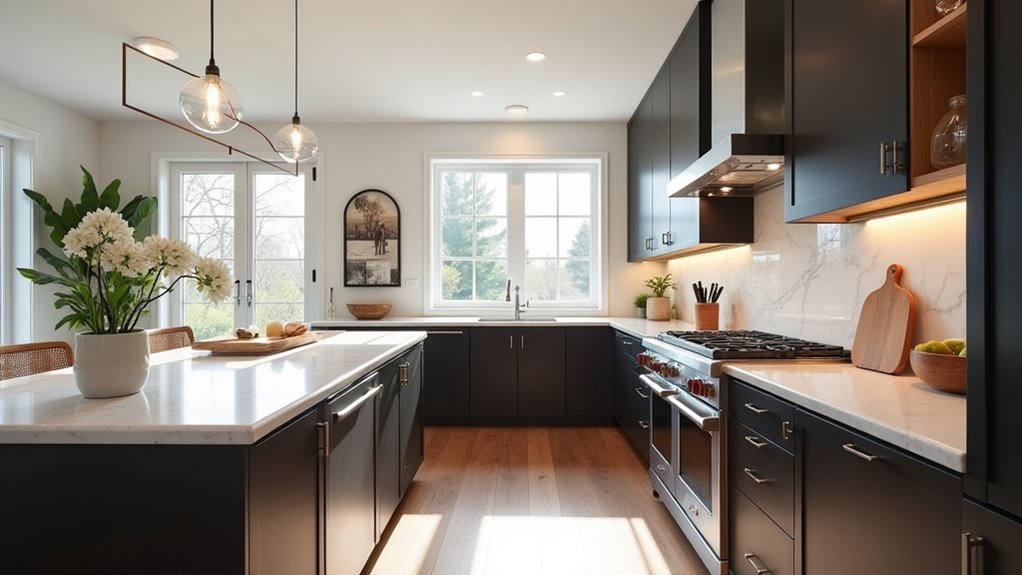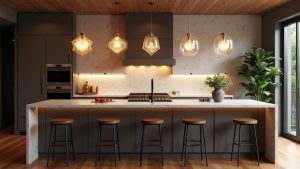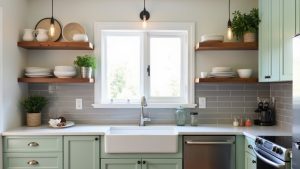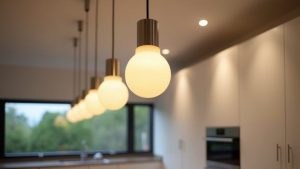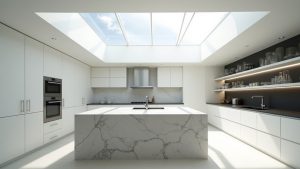Mixing dark and light kitchen cabinets can transform a space with chic contrast. First, balance tones using the 60-30-10 rule for harmony. Place dark hues on lower cabinets for grounding, light ones above for airiness. Create depth with a bold, contrasting island. Harmonize textures—matte darks, glossy lights. Use strategic lighting like under-cabinet illumination to enhance vibes. Coordinate with neutral countertops and cohesive hardware. Stick around to uncover deeper design secrets for your kitchen!
Key Takeaways
- Use dark lower cabinets for grounding and light upper cabinets for an airy feel.
- Follow the 60-30-10 rule for balanced color proportions.
- Pair similar undertones in shades for a seamless, cohesive look.
- Add contrasting hardware finishes to connect light and dark cabinets stylishly.
- Maximize natural light to highlight and enhance cabinet color contrast.
Balancing Dark and Light Tones for Visual Harmony
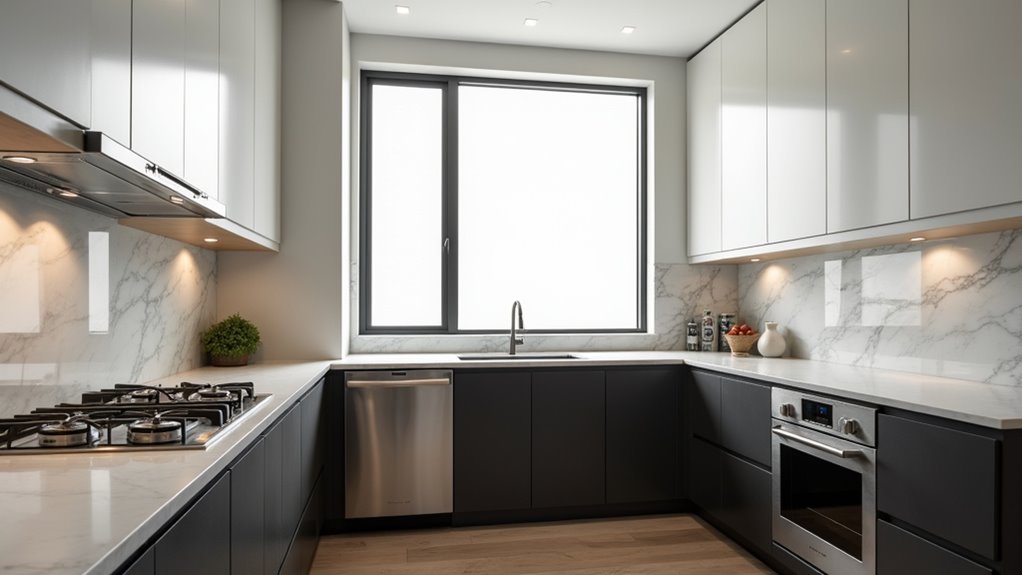
While designing a kitchen with mixed cabinet tones can seem daunting, achieving visual harmony between dark and light shades is an art form that transforms spaces into stylish havens. The key lies in mastering proportions and contrast for dark cabinet harmony.
Crafting a kitchen with mixed cabinet tones is an art, blending dark and light shades to create stunning, harmonious, and stylish spaces.
Employing the trendy 60-30-10 rule—60% dominant color, 30% secondary, and 10% accent—ensures a balanced aesthetic. Darker hues ground the space with a sophisticated edge, while the light cabinet appeal opens up the room, reflecting light for an airy vibe. Following this rule helps in achieving a cohesive design that enhances the kitchen’s overall aesthetic appeal cohesive design enhances. Additionally, using darker colors on lower cabinets can create a strong visual anchor, enhancing the grounded feel of the space strong visual anchor.
To elevate cohesion, pairing shades with similar undertones or balancing warm and cool tones creates a seamless look. Textures also play a chic role; glossy finishes enhance light cabinet appeal, while matte dark cabinets add depth.
Subtle contrasts, like stark hardware against opposing tones, captivate the eye. With mindful color and texture interplay, a kitchen becomes a curated masterpiece of style and balance.
Choosing the Right Placement for Color Impact
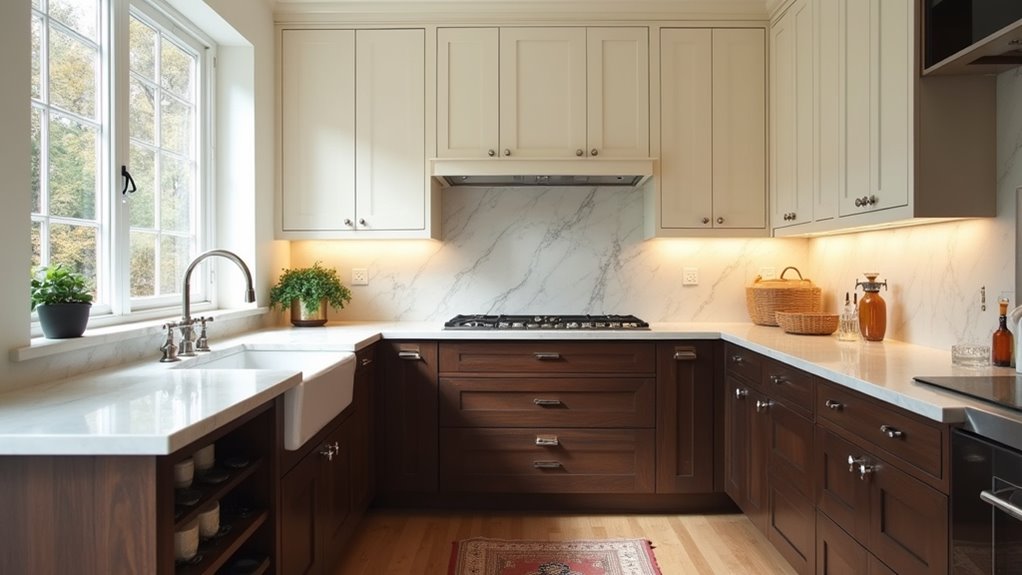
When crafting a kitchen with mixed cabinet tones, strategic color positioning becomes the secret sauce for a stunning design.
Placing darker shades on lower cabinets can anchor the space, while lighter hues above elevate the room’s airy vibe and balance visual weight.
This thoughtful approach ensures a dynamic yet harmonious look that’s right on trend.
Strategic Color Positioning
Crafting a kitchen with striking visual appeal starts with strategic color positioning, a design approach that transforms cabinetry into a canvas of impact. By embracing color trends and understanding color psychology, designers can evoke specific moods—think calming light tones for airy openness or bold dark hues for cozy sophistication.
Placing darker shades on lower cabinets grounds the space, while lighter upper cabinets create an uplifting vibe. A vibrant island can become a trendy focal point, drawing the eye with contrasting flair. Highlighting architectural gems like a unique hood or open shelving with daring colors adds personality.
Considering kitchen size and lighting ensures the palette enhances spatial perception, making strategic placement a game-changer for modern, impactful kitchen design.
Balancing Visual Weight
As kitchen design evolves into a bold expression of style, balancing visual weight through color placement becomes a pivotal strategy for creating harmony and impact.
Achieving color balance transforms kitchen aesthetics, ensuring a space feels both inviting and dynamic. Darker tones on lower cabinets ground the room, while lighter uppers elevate openness and reflect light. A bold island can anchor the layout, drawing the eye with intention.
Consider room size—lighter shades expand smaller kitchens, while larger spaces welcome daring contrasts.
Feel the magic of thoughtful design with:
- A grounded sanctuary from dark lowers.
- Airy freedom with light uppers.
- A striking island as your heart.
- Spatial illusion that breathes life.
- Timeless harmony in every glance.
Creating Depth With Contrasting Elements
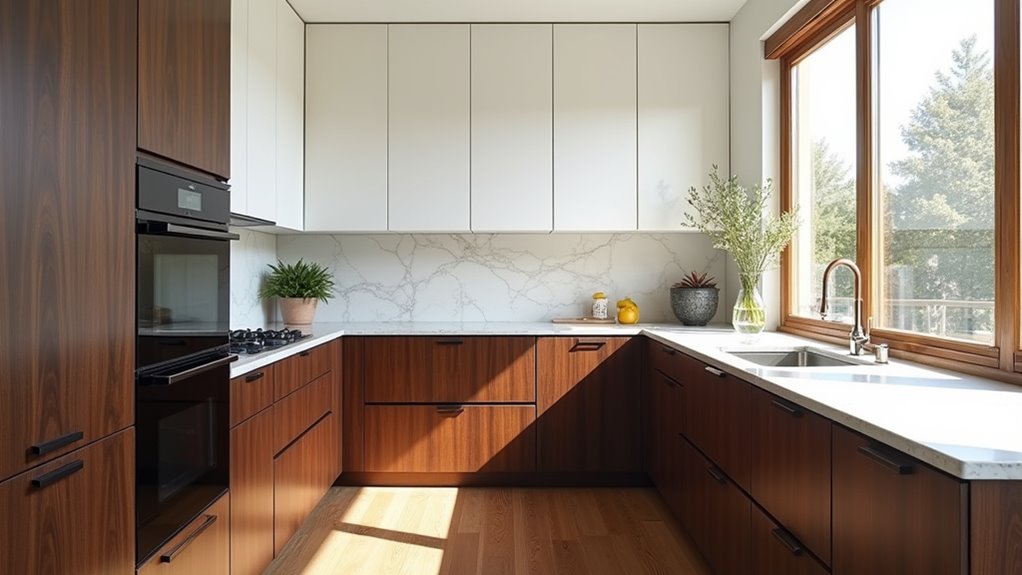
While designing a kitchen with striking visual appeal, incorporating contrasting elements like dark and light cabinets can transform the space into a dynamic masterpiece. This approach enhances depth perception by playing with visual hierarchy, where darker lower cabinets ground the room and lighter uppers elevate the eye, crafting an illusion of height. Contrasting finishes amplify this effect, turning a mundane kitchen into a trendy haven of layered sophistication.
Strategically, a dark island can anchor the layout, while light perimeter cabinets keep the ambiance airy. This interplay not only enlarges smaller spaces but also refines the overall aesthetic. Consider the following design tactics:
| Element | Color Strategy | Visual Impact |
|---|---|---|
| Upper Cabinets | Light Tones | Opens up space |
| Lower Cabinets | Dark Shades | Grounds the design |
| Kitchen Island | Contrasting Hue | Creates focal point |
Such thoughtful contrasts ensure a captivating, modern kitchen narrative.
Harmonizing Materials and Textures
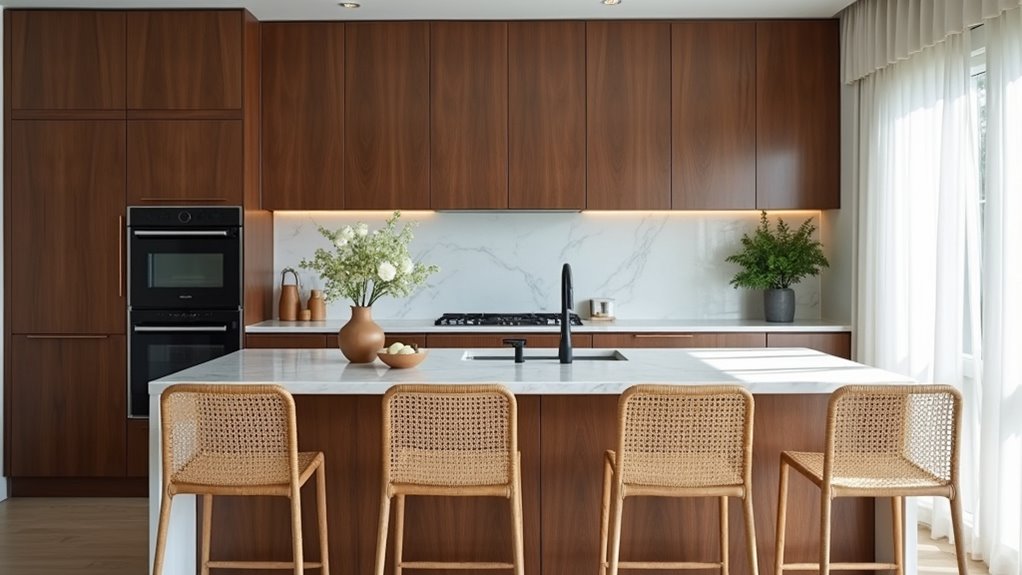
Many designers recognize that harmonizing materials and textures is the secret to elevating a kitchen with dark and light cabinets into a cohesive, stylish space.
By exploring material combinations, such as natural wood with painted finishes or matte black cabinets with glossy white uppers, a kitchen can achieve a dynamic yet balanced look.
Texture contrasts, like pairing stone countertops with warm oak lowers or adding metallic hardware, introduce depth and sophistication.
To inspire a transformative vision, consider these evocative elements:
- Imagine the warmth of golden wood embracing crisp white cabinets.
- Feel the sleek allure of brushed gold hardware against dark wood.
- Envision stone countertops grounding a modern two-tone design.
- Sense the rustic charm of textured tiles in a neutral backsplash.
- Picture metal accents sparking intrigue amid contrasting cabinetry.
These thoughtful choices in material combinations and texture contrasts craft a kitchen that feels both trendy and timeless.
Enhancing the Design With Strategic Lighting
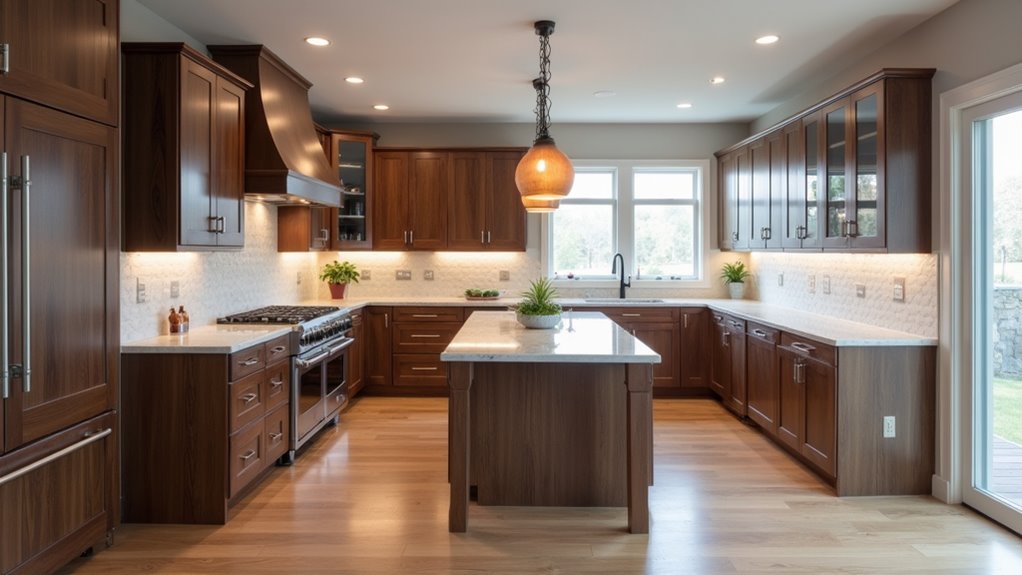
When crafting a kitchen with mixed dark and light cabinets, under-cabinet illumination becomes a game-changer, casting a sleek glow on countertops while banishing shadows for a modern, functional vibe.
Pendant lighting, strategically hung over islands, steals the spotlight as both a bold design statement and a focused beam for culinary tasks.
Maximizing natural light, on the other hand, transforms the space by playing off cabinet hues, enhancing brightness and creating a dynamic, airy feel throughout the day.
Under-Cabinet Illumination Benefits
As kitchen design evolves with bold contrasts like mixed dark and light cabinets, under-cabinet illumination emerges as a game-changer for both functionality and flair.
This trendy lighting solution, with various under cabinet styles, enhances visibility through task focused lighting, banishing shadows and ensuring precision during meal prep. It also elevates aesthetics by highlighting textures and balancing color contrasts, while creating a warm, inviting ambiance with dimmable options.
Experience the transformative power of under-cabinet lighting with these emotional impacts:
- Revel in a safer, brighter workspace.
- Feel the luxury of a sophisticated kitchen glow.
- Embrace cozy evenings with a soft, warm light.
- Delight in showcasing stunning backsplashes effortlessly.
- Sense spaciousness in even the darkest kitchen corners.
Pendant Lighting Focal Impact
Pendant lighting emerges as a captivating centerpiece in kitchens with mixed dark and light cabinets, effortlessly elevating the design with strategic flair.
Thoughtful pendant selection transforms islands into focal points, balancing the visual interplay of contrasting tones with modern, industrial, or farmhouse styles. Materials like warm metallics or two-tone finishes enhance depth, harmonizing with cabinet aesthetics.
Strategically placed pendants create order, while dimmable options allow for ambient adjustment, shifting from bright task lighting to a cozy glow.
Unique shapes and metallic reflections add trendy allure, accentuating the kitchen’s mood. Positioned at optimal heights, these fixtures merge function with artistry, ensuring focused illumination over key areas while reinforcing the striking contrast of a two-tone palette.
Maximizing Natural Light Effects
While the interplay of dark and light kitchen cabinets creates a stunning visual contrast, maximizing natural light becomes essential to elevate this design into a luminous masterpiece.
Clever light reflection techniques can transform a kitchen into a radiant haven. Incorporating reflective surfaces, such as glossy finishes on upper cabinets, mirrored backsplashes, and polished quartz countertops, amplifies natural light, banishing shadows.
Strategically placing workstations near windows and opting for sheer curtains ensures an airy ambiance. Skylights and glass doors further enhance brightness, blending functionality with style.
Feel the glow with these inspiring ideas:
- *Bask in sunlight streaming through expansive windows.*
- *Marvel at light dancing off metallic fixtures.*
- *Savor the spaciousness of open shelving.*
- *Delight in mirrored accents sparkling subtly.*
- *Cherish a kitchen alive with warmth.*
Coordinating Cabinets With Surrounding Features
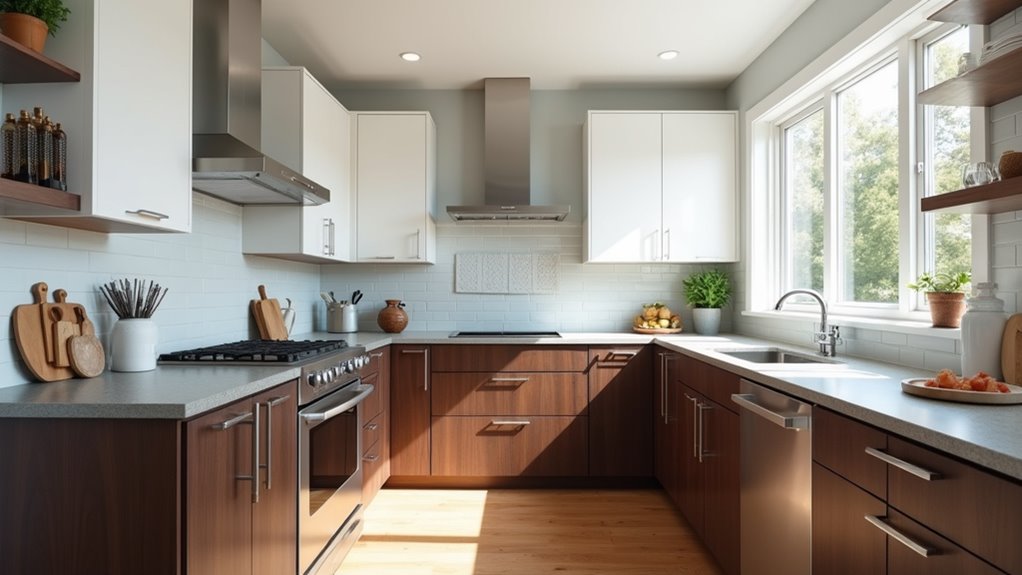
When designing a kitchen with mixed dark and light cabinets, coordinating with surrounding features is essential to achieve a harmonious and stylish space.
Thoughtful countertop choices, like neutral quartz or a mid-tone surface, can bridge the contrast between cabinet shades, creating visual flow.
Selecting countertops with neutral quartz or mid-tone hues effortlessly unifies dark and light cabinets, ensuring a smooth and cohesive visual flow.
Flooring options should complement both tones—light floors brighten dark lowers, while darker ones ground lighter uppers with textural intrigue.
Backsplash design acts as a chic connector, blending cabinet hues or adding a trendy pattern for flair.
Wall colors, whether soft neutrals or bold accent shades, frame the dual-toned look, making cabinets pop or grounding the space with sophistication.
Finally, appliance integration ensures a seamless aesthetic, aligning finishes with the kitchen’s vibe for a polished result.
Selecting Complementary Accents and Hardware
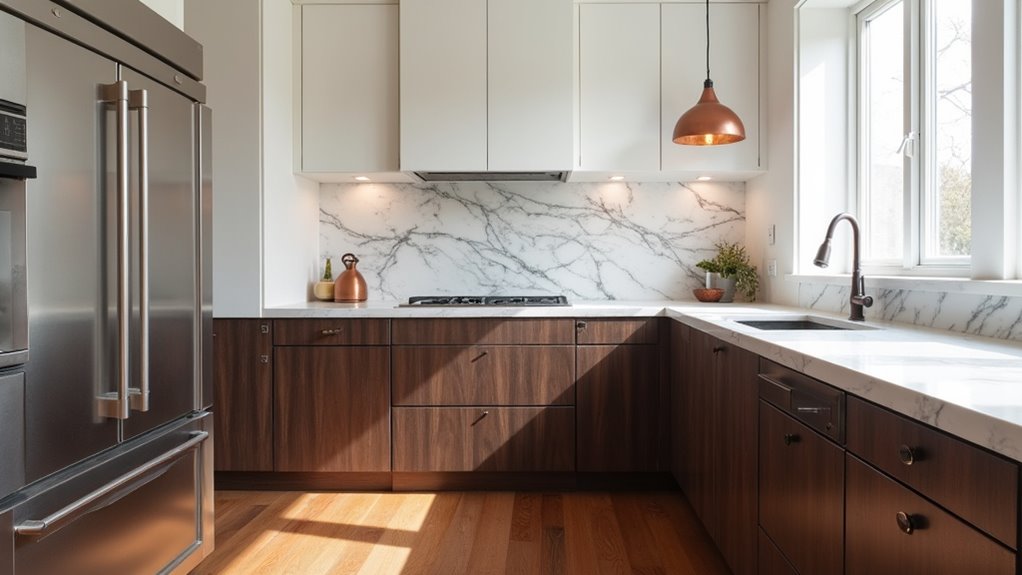
Savvy designers know that after harmonizing cabinets with surrounding elements, the next step lies in perfecting the finer details. Selecting complementary accents and hardware can elevate a kitchen’s dual-toned charm.
Opting for cohesive hardware finishes, like matte black or warm brass, ties light and dark cabinets together, while contrasting finishes add daring flair. Knob styles, whether sleek pulls or classic knobs, must match the cabinet’s vibe—modern or rustic. Dual toned accents in hardware, blending materials like lucite and bronze, offer a chic twist.
backsplashes integration also plays a pivotal role, bridging cabinet colors or popping with bold patterns for drama.
Feel the magic of design with these touches:
- Imagine warm brass hardware glowing against dark cabinets.
- Picture sleek pulls transforming mundane drawers.
- Envision dual toned accents sparking curiosity.
- See a backsplash weaving light and dark seamlessly.
- Feel the kitchen’s soul in every detail.
